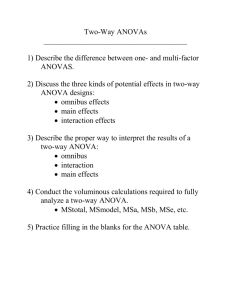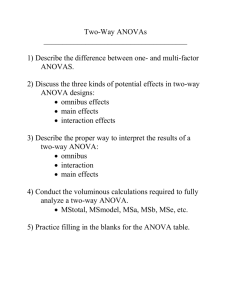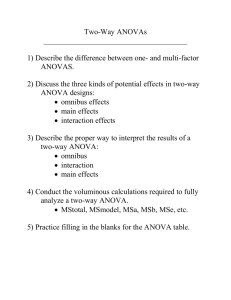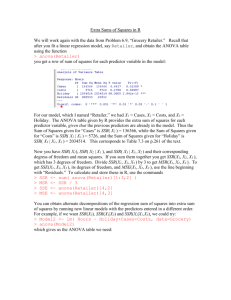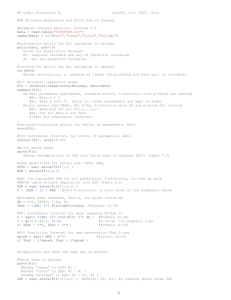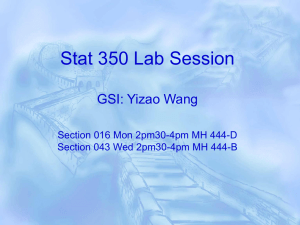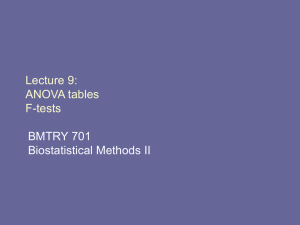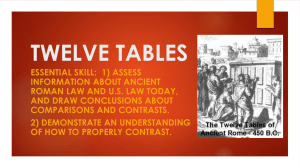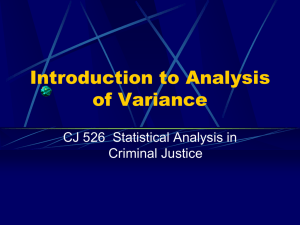Comparing several means: ANOVA (GLM 1)
advertisement
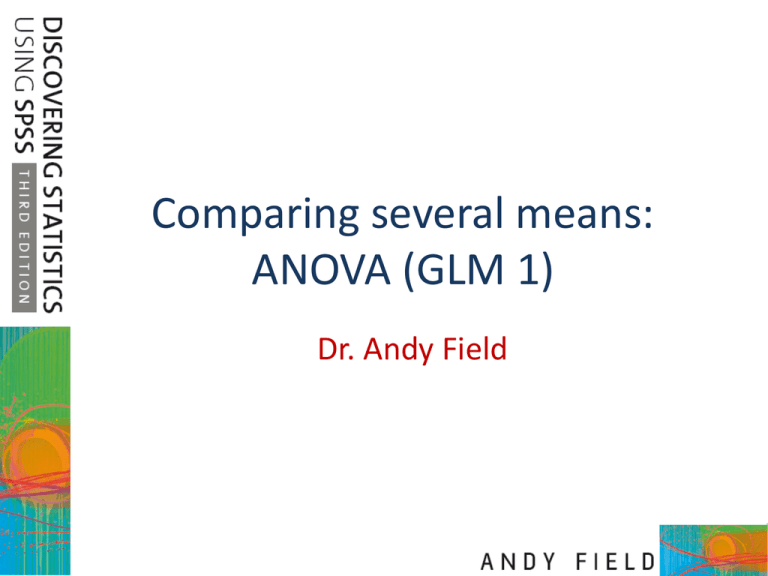
Comparing several means: ANOVA (GLM 1) Dr. Andy Field Aims • Understand the basic principles of ANOVA – Why it is done? – What it tells us? • Theory of one-way independent ANOVA • Following up an ANOVA: – Planned Contrasts/Comparisons • Choosing Contrasts • Coding Contrasts – Post Hoc Tests Slide 2 When And Why • When we want to compare means we can use a ttest. This test has limitations: – You can compare only 2 means: often we would like to compare means from 3 or more groups. – It can be used only with one Predictor/Independent Variable. • ANOVA – Compares several means. – Can be used when you have manipulated more than one Independent Variables. – It is an extension of regression (the General Linear Model) Slide 3 Why Not Use Lots of t-Tests? • If we want to compare several means why don’t we compare pairs of means with t-tests? – Can’t look at several independent variables. – Inflates the Type I error rate. 1 1 2 2 2 3 3 Slide 4 1 3 FamilywiseError 1 0.95 n What Does ANOVA Tell us? • Null Hyothesis: – Like a t-test, ANOVA tests the null hypothesis that the means are the same. • Experimental Hypothesis: – The means differ. • ANOVA is an Omnibus test – It test for an overall difference between groups. – It tells us that the group means are different. – It doesn’t tell us exactly which means differ. Slide 5 Experiments vs. Correlation • ANOVA in Regression: – Used to assess whether the regression model is good at predicting an outcome. • ANOVA in Experiments: – Used to see whether experimental manipulations lead to differences in performance on an outcome (DV). • By manipulating a predictor variable can we cause (and therefore predict) a change in behaviour? – Asking the same question, but in experiments we systematically manipulate the predictor, in regression we don’t. Slide 6 Theory of ANOVA • We calculate how much variability there is between scores – Total Sum of squares (SST). • We then calculate how much of this variability can be explained by the model we fit to the data – How much variability is due to the experimental manipulation, Model Sum of Squares (SSM)... Slide 7 • … and how much cannot be explained – How much variability is due to individual differences in performance, Residual Sum of Squares (SSR). Rationale to Experiments Group 1 Group 2 Lecturing Skills • Variance created by our manipulation – Removal of brain (systematic variance) • Variance created by unknown factors – E.g. Differences in ability (unsystematic variance) Slide 8 = 10 10 8 M = 10 M=9 M = 11 4 M = 10 M=9 M=8 M = 12 Mean = 10 SD = 1.22 4 10 8 3 Frequency 2 0 M = 11 M = 10 6 6 2 4 1 2 0 6 7 8 9 10 11 Sample Mean 12 13 14 0 Theory of ANOVA • We compare the amount of variability explained by the Model (experiment), to the error in the model (individual differences) – This ratio is called the F-ratio. • If the model explains a lot more variability than it can’t explain, then the experimental manipulation has had a significant effect on the outcome (DV). Slide 10 Theory of ANOVA • If the experiment is successful, then the model will explain more variance than it can’t – SSM will be greater than SSR Slide 11 ANOVA by Hand • Testing the effects of Viagra on Libido using three groups: – Placebo (Sugar Pill) – Low Dose Viagra – High Dose Viagra • The Outcome/Dependent Variable (DV) was an objective measure of Libido. Slide 12 The Data Slide 13 The data: 8 7 6 5 Mean 3 4 3 2 1 Mean 2 Grand Mean Mean 1 0 0 1 2 3 4 Total Sum of Squares (SST): 8 7 6 5 4 3 Grand Mean 2 1 0 0 Slide 15 1 2 3 4 Step 1: Calculate SST SST (xi x grand )2 2 N 1 SST s grand SST 3.12415 1 43.74 Slide 16 2 s (NSS1) SS s 2 N 1 Degrees of Freedom (df) • Degrees of Freedom (df) are the number of values that are free to vary. – Think about Rugby Teams! • In general, the df are one less than the number of values used to calculate the SS. dfT N 1 15 1 14 Slide 17 Model Sum of Squares (SSM): 8 7 6 5 4 3 Grand Mean 2 1 0 0 Slide 18 1 2 3 4 Step 2: Calculate SSM SSM ni (xi x grand )2 SS M 52.2 3.4672 53.2 3.4672 55.0 3.4672 5 1.2672 5 0.2672 51.5332 8.025 0.355 11.755 20.135 Slide 19 Model Degrees of Freedom • How many values did we use to calculate SSM? – We used the 3 means. dfM k 1 3 1 2 Slide 20 Residual Sum of Squares (SSR): 8 7 6 5 4 3 Grand Mean 2 1 0 0 1 Df = 4 Slide 21 2 Df = 4 3 Df = 4 4 Step 3: Calculate SSR SSR (xi xi ) SSR SSR Slide 22 2 2 s group1 2 si ni 1 n1 1 2 s group 2 2 s (NSS1) SS s 2 N 1 n2 1 2 s group 3 n3 1 Step 3: Calculate SSR 2 2 2 SS R s group n 1 s n 1 s 1 1 group 2 2 group 3 n3 1 1.705 1 1.705 1 2.505 1 1.70 4 1.70 4 2.50 4 6.8 6.8 10 23.60 Slide 23 Residual Degrees of Freedom • How many values did we use to calculate SSR? – We used the 5 scores for each of the SS for each group. dfR dfgroup 1 dfgroup 2 dfgroup 3 n1 1 n2 1 n3 1 5 1 5 1 5 1 12 Slide 24 Double Check SST SS M SS R 43.74 20.14 23.60 43.74 43.74 dfT dfM dfR 14 2 12 14 14 Slide 25 Step 4: Calculate the Mean Squared Error SS M 20.135 MSM 10.067 dfM 2 SSR 23.60 MSR 1.967 dfR 12 Slide 26 Step 5: Calculate the F-Ratio M SM F M SR MSM 10.067 F 5.12 MSR 1.967 Slide 27 Step 6: Construct a Summary Table Slide 28 Source SS df MS F Model 20.14 2 10.067 5.12* Residual 23.60 12 1.967 Total 43.74 14 Why Use Follow-Up Tests? • The F-ratio tells us only that the experiment was successful – i.e. group means were different • It does not tell us specifically which group means differ from which. • We need additional tests to find out where the group differences lie. Slide 29 How? • Multiple t-tests – We saw earlier that this is a bad idea • Orthogonal Contrasts/Comparisons – Hypothesis driven – Planned a priori • Post Hoc Tests – Not Planned (no hypothesis) – Compare all pairs of means • Trend Analysis Slide 30 Planned Contrasts • Basic Idea: – The variability explained by the Model (experimental manipulation, SSM) is due to participants being assigned to different groups. – This variability can be broken down further to test specific hypotheses about which groups might differ. – We break down the variance according to hypotheses made a priori (before the experiment). – It’s like cutting up a cake (yum yum!) Slide 31 Rules When Choosing Contrasts • Independent – contrasts must not interfere with each other (they must test unique hypotheses). • Only 2 Chunks – Each contrast should compare only 2 chunks of variation (why?). • K-1 – You should always end up with one less contrast than the number of groups. Slide 32 Generating Hypotheses • Example: Testing the effects of Viagra on Libido using three groups: – Placebo (Sugar Pill) – Low Dose Viagra – High Dose Viagra • Dependent Variable (DV) was an objective measure of Libido. • Intuitively, what might we expect to happen? Slide 33 Mean Slide 34 Placebo Low Dose High Dose 3 5 7 2 2 4 1 4 5 1 2 3 4 3 6 2.20 3.20 5.00 How do I Choose Contrasts? • Big Hint: – In most experiments we usually have one or more control groups. – The logic of control groups dictates that we expect them to be different to groups that we’ve manipulated. – The first contrast will always be to compare any control groups (chunk 1) with any experimental conditions (chunk 2). Slide 35 Hypotheses • Hypothesis 1: – People who take Viagra will have a higher libido than those who don’t. – Placebo (Low, High) • Hypothesis 2: – People taking a high dose of Viagra will have a greater libido than those taking a low dose. – Low High Slide 36 Planned Comparisons Slide 37 Another Example Another Example Coding Planned Contrasts: Rules • Rule 1 – Groups coded with positive weights compared to groups coded with negative weights. • Rule 2 – The sum of weights for a comparison should be zero. • Rule 3 – If a group is not involved in a comparison, assign it a weight of zero. Slide 40 Coding Planned Contrasts: Rules • Rule 4 – For a given contrast, the weights assigned to the group(s) in one chunk of variation should be equal to the number of groups in the opposite chunk of variation. • Rule 5 – If a group is singled out in a comparison, then that group should not be used in any subsequent contrasts. Slide 41 Chunk 1 Low Dose + High Dose +1 Chunk 2 Placebo Contrast 1 Positive Negative 1 2 Magnitude -2 Weight +1 Sign of Weight Chunk 1 Low Dose Chunk 2 High Dose Contrast 2 Placebo Not in Contrast Sign of Weight Positive Negative 1 1 Magnitude 0 +1 -1 Weight 0 Output o f o C o 1 2 Slide 44 Post Hoc Tests • Compare each mean against all others. • In general terms they use a stricter criterion to accept an effect as significant. – Hence, control the familywise error rate. – Simplest example is the Bonferroni method: Bonferroni Slide 45 N umberof T es ts Post Hoc Tests Recommendations: • SPSS has 18 types of Post hoc Test! • Field (2009): – Assumptions met: • REGWQ or Tukey HSD. – Safe Option: • Bonferroni. – Unequal Sample Sizes: • Gabriel’s (small n), Hochberg’s GT2 (large n). – Unequal Variances: • Games-Howell. Slide 46 Post Hoc Test Output Trend Analysis Trend Analysis: Output
